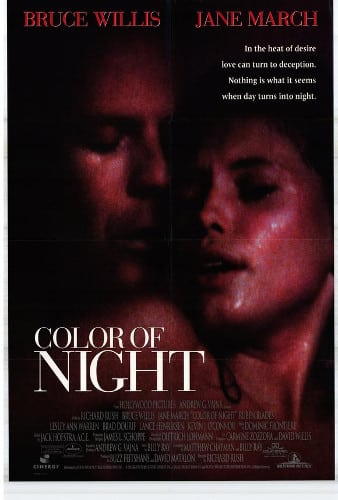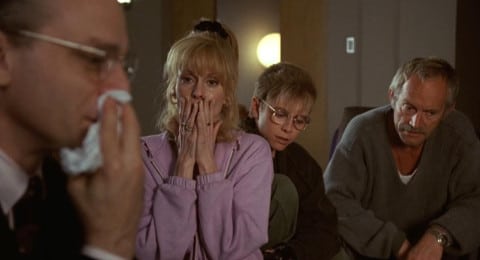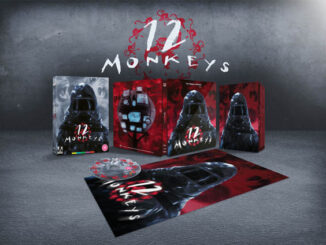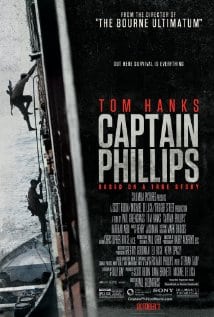Color of Night (1994)
Directed by: Richard Rush
Written by: Billy Ray, Matthew Chapman, Richard Rush
Starring: Bruce Willis, Jane March, Lesley Ann Warren, Rubén Blades
USA
AVAILABLE ON BLU-RAY [REGION ‘A’, REGION ‘B’ SPAIN ONLY] AND DVD
RUNNING TIME: 140 mins [uncut director’s cut]/ 139 mins [censored director’s cut]/ 122 mins [uncut theatrical version/ 121 mins [censored theatrical version]
REVIEWED BY: Dr Lenera, Official HCF Critic
SPOILERS!
Dr. Bill Capa, a New York psychiatrist, is rendered unable to see the colour red and falls into a deep depression after an unstable patient commits suicide in front of him by jumping from his office window. He travels to Los Angeles to stay with a friend, fellow therapist Dr. Bob Moore, who invites him to sit in on a group therapy session, but Bob is murdered in his office. Lt. Hector Martinez considers everyone in Moore’s therapy group, including Bill, as suspects, so against his advice Bill decides to take the therapy group. He also begins a passionate affair with Rose, a mysterious young woman who comes and goes….
This review will be quite spoiler heavy, but revealing a plot twist in the first paragraph may just be the easiest and quickest way for me to describe how daft this bonkers melding of the erotic thriller and the giallo is. Jane March, who was hot in 1994 and is obviously not so now but who is always featured on posters and video/DVD/Blu-ray covers of this movie so most people watching the film will know what she looks like, is the female star. Around ten minutes in, Bruce Willis’s character Bill attends a therapy session with five neurotics, one of whom is a nervous boy called Richie who finds it hard to speak and who has gender issues [no doubt the PC lot would attack this film if it were released today]. It’s plain obvious that this person is Jane March with glasses and a wig, the filmmakers having not made hardly any attempt whatsoever to hide the fact – and yet when Bill meets Jane as his sexy “dream woman” later on in the story, he fails to recognise her even though there’s no mistaking those choppers – and then at the end her identity is intended to be a big secret! It could be the most obvious, poorly hidden dual-role twist in movie history, so much so that the first time I saw the film I genuinely didn’t realise it was supposed to be a twist until the end. It’s possible that director Richard Rush decided to treat this as something of a joke considering how Billy Ray and Michael Chapman’s screenplay is literally crammed with idiocy itself, including countless irrelevances such as frequently reminding us that Bill can’t see the colour red yet this gimmick having no effect on the actual plot whatsoever, plus dialogue that is very odd indeed. But as this is a ‘guilty pleasure’ review, I have no shame in admitting I always have a good time watching Color Of Night, finding its sheer eccentricity rather beguiling.
This was the usually good Richard Rush’s [The Stunt Man, Freebie And The Bean] first film in 14 years. It was not a project he initiated but he did rewrite Ray and Chapman’s script. He wanted Steve Railsback to play Buck, but Willis had final decision over casting and vetoed this. March, despite being cast due to her role in the raunchy The Lover, decided she didn’t want to do her nudity just before filming the first sex scene and Rush had to spend ages talking her into it. Rush had final cut, but producer Andrew G. Vajna was disappointed in test screenings so put together a version running 18 minutes shorter, removing much material concerning Buck, Martinez and Sandra that he considered irrelevant, splitting up the sex montage into three different scenes spread out, and shortening the ending so that Bill and Rose were together. But he also cut the heads and tails of many scenes, destroying the way Rush carefully planned out his shots to connect the end of a scene with the beginning of the next one. He also added restored some shots Rush had removed. Rush agreed to let them release this version if it scored higher with test audiences, but it tested even worse. Rush was then fired and had a heart attack creating a PR disaster, so Vajna allowed for Rush’s cut to come out on video, though Rush was unable to edit his ending into the film. As for the sex, most countries outside the US saw around an extra minute of material and the most explicit version is actually the UK full screen DVD, extra picture information revealing an extra shot of Bruce’s Willis. The cinema release flopped and won the Golden Raspberry Award for Worst Picture, though the video release of the longer cut was very popular.
When the first scene shows a woman fellating a hand gun whilst putting on makeup, and the next scene has our hero ask the same woman to look in a mirror and tell him what she sees yet she doesn’t seem to look in any mirror at all and Bill doesn’t comment on this when she talks back to him, you already have a good idea of what you’re going to get. The woman’s suicide in this that follows also indicates what you’re going to get too: as she falls for what seems like ages, for a couple of seconds you see her body reflected in the windows of a building and it looks rather artistic. Throughout this film, there are some nice, sometimes even clever shots which, along with the connections between scenes in the director’s cut such as a helicopter appearing after Bob’s been murdered cutting to Bill arriving at the crime scene in another helicopter, show that Rush did care how his film looked even if he didn’t seem to care about much else. Bill visits his mate Bob [Scott Bakula, giving probably the most natural and unaffected performance in the film] and sits in on his therapy group, and this is the first of several bizarre sequences featuring temperamental OCD sufferer and ex-lawyer Clark, nymphomaniac and kleptomaniac Sandra, suicidal ex-cop Buck who lost his wife and daughter, alienated sadomasochistic painter Casey, and Richie, a 16-year old boy who wants to be a woman. Seeing the likes of Brad Dourif, Lance Henricksen and Lesley Ann Warren continually snipe, shout and occasionally even attack each other, sometimes backed by comic music [basically a variation on composer Domonic Frontiere’s main theme for Freebie And The Bean], is amusingly strange fun, coming across like a surreal version of whenever Agatha Christie had a load of murder suspects all in one room, even though the material here that’s important to the plot could have been covered in just a couple of minutes. Dourif and co. treat the film as a comedy – in fact virtually everyone in the film treats it as a comedy except for Willis who takes it all very seriously and seems to be acting in a totally different movie to everybody else.
Bob’s been getting death threats and is soon stabbed to death in a very Dario Argento-esque scene with him crashing through glass. Investigating cop Hector then turns up, and Ruben Blades’s character, an exaggerated caricature of a greasy sleazy Hispanic [I would say that it’s hard to get offended by the depiction though no doubt the snowflake mob would do so today] cop, is one of the comic high points of the film. Possibly his two most priceless moments [it’s hard to decide] have him walking along the street with Bill [who for some reason is still allowed to live in Bob’s expensive mansion and drive his car] and suddenly ramming up against a car and searching a poor guy who accidentally bumps into him, and after he sees Rose whom Bill encountered when they have a fender bender, saying: “That’s a very young girl to be going around fending benders”, which could be one of the worst double entendres ever, it’s not even at all appropriate if you think about it. Rose appears to be the girl of Bill’s dreams, and they waste little time in getting down to it, though March and Willis have no sexual chemistry whatsoever and the lovemaking has some awkward edits even in the uncut versions of the scenes. I should here probably mention something that I forgot to do so in my background paragraph – the two shots of Willis’s cock are actually of a stand-in. Apparently Rush considered Bruce’s member to be too small.
Color of Night does drag around the middle and for once I admit that the theatrical cut, despite losing some great Blades material, could be the better film for speeding things up and removing the lesbian antics of Sandra and a young woman who looks suspiciously like Jane March: the ten viewers who dodn’t spot March at the beginning would have the revelation that Rose has other identities delayed, keeping the ‘mystery’ for a bit longer, though cutting this and other extraneous footage does diminish the film’s odd feel a bit. Whenever it seems to slow down just a bit too much you sometimes get an attempt on Bill’s life randomly plonked in, and the finale makes great use of a nail gun and not bad acting by March who’s pretty atrocious elsewhere – though of course this is something many male viewers can probably partly forgive considering the eagerness with which her clothes fall off. The revelation of the killer isn’t badly done really and the story is appropriately sleazy and sordid in giallo fashion, though I’d liked to have seen the others murders too. There’s lots of obvious visual symbolism with mirrors and use of a glass ornament that creates multiple reflections. And every now and again, you get something which is just plain weird, like in the director’s cut Willis speaking what sound more like stage directions than narration, like: “She floats away on her sweet young legs, waves to him once, and drives away without a backwards glance”. A bit near the end deserves a special mention. Some time after a car chase in which a car with blacked-out windows tries to force Bill off the road, the car appears again on the roof of a car park. It’s obvious that the driver of the car can’t see over the edge and know where Bill is, and it’s even more obvious that he or she wouldn’t have a clue where Bill was in the time it takes to push another car over the edge, yet this other car still misses Bill by just a few inches. Throughout, Willis, giving one of his “don’t give a s***” performances that he does periodically, barely reacts to the insanity going on around him.
The film’s music situation is odd. For some reason, the theatrical cut features Frontiere’s temp score, entirely on synthesisers though intended to be re-recorded by a orchestra. For the director’s cut, they re-recorded some of the cues for full orchestra though only some, so it sounds like the director’s cut has two different scores sharing some of the same musical material. The main theme, sung by Lauren Christie over the end credits, is rather nice and catchy, though there’s probably far too much scoring in the film, loud suspense music often playing when there doesn’t need to be anything and sometimes causing unintentional laughs – or maybe these laughs were intended? It’s hard to tell what on earth Rush and the other screenwriters were trying to do with Color Of Night, which is the reason [honest] that I’m going to buy the soon-to-be-released Region ‘A’ Blu-ray which has audio commentaries from both Rush and Chapman. I wonder if they’ll spend ages apologising for it like Joel Schumacher did on his Batman And Robin commentary. The material and the plot could have actually resulted in a truly dark, disturbing psycho-sexual thriller, which is maybe one thing that causes me to enjoy watching it every now and again. In amidst all the laughs and WTF moments there remain a few signs of what could have been – though in the end I’m rather glad Color Of Night turned out the way it did because it;s just so eccentric and quirky and contains a hell of a lot to enjoy for the person who likes to watch a bad movie once in a while. Films like this, though not science fiction or fantasy, don’t take place in anything resembling the real world – but then I probably don’t entirely live in the real world either.
Rating: 


















Be the first to comment